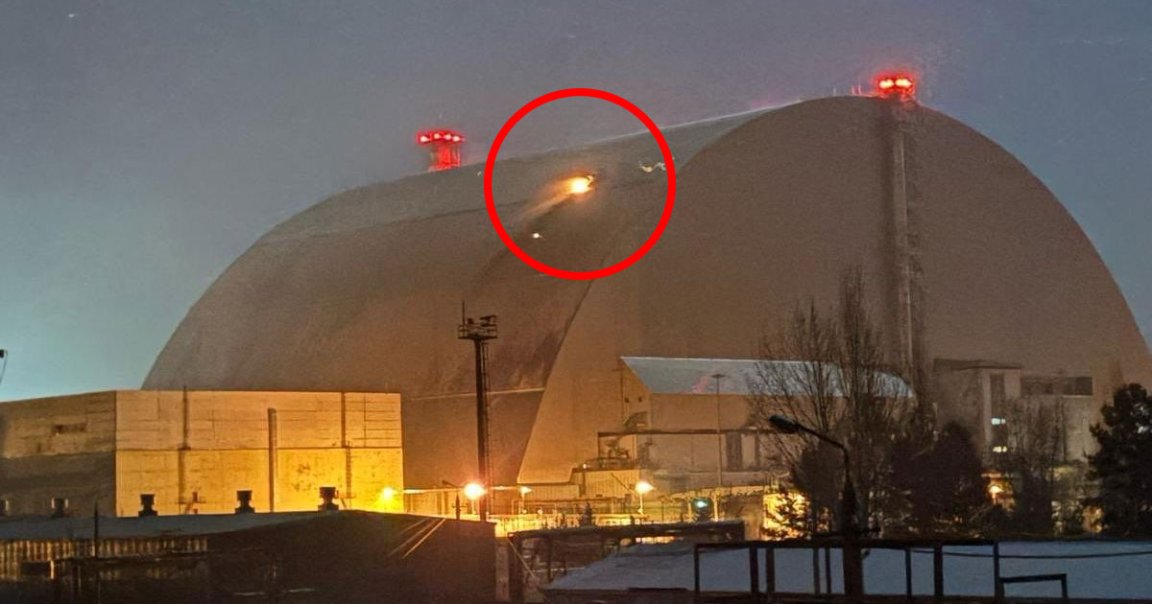
An armed drone has hit the protective outer shell of Ukraine’s Chernobyl nuclear plant, the site of the worst nuclear accident in history.
While the drone’s warhead briefly started a fire, radiation levels haven’t increased, according to the UN International Atomic Energy Agency. To do so, the melted-down facility’s inner containment shell, dubbed New Safe Confinement (NSC), which was built to prevent radiation leaks immediately following the 1896 disaster, would have to be breached as well.
“Fire safety personnel and vehicles responded within minutes,” the IAEA wrote in an update on X-formerly-Twitter. “At this moment, there is no indication of a breach in the NSC’s inner containment.”
A video of the incident shows a considerable fire in the structure’s roof, spewing smoke.
As the Associated Press reports, Ukrainian officials blamed the incident on Russia, although the Kremlin has denied any involvement.
It’s a precarious moment for the war that’s been raging for three years now. President Donald Trump signaled earlier this week that he would meet with Russian president Vladimir Putin to discuss ways to end the conflict. While it appeared as if Ukrainian president Volodymyr Zelensky would be sidelined, Trump has since claimed that “of course” he would also be part of the negotiations.
Ukrainian front lines have been pushed back by Russia’s army as of late, but whether assistance from the West will come in time to prevent major losses for Ukraine remains to be seen.
Apart from the site of Chernobyl, Ukraine’s Zaporizhzhia nuclear plant, which is Europe’s largest, has already been the target of several drone strikes, though it has yet to suffer any major damage. Russia occupied the facility in 2022 at gunpoint, and it hasn’t generated any power since then.
Chernobyl’s “sarcophagus” NSC was built to house the melted-down number 4 reactor immediately following the 1986 disaster. An even more enormous secondary outer shell of steel and concrete, added in 2016 to envelop the shelter, was designed to provide additional protection for the next 100 years.
According to images released by the IAEA, the armed drone punched a hole through the roof of the outer shell.
It’s still unclear who was behind the strike. A Kremlin spokesperson told the AP that “there is no talk about strikes on nuclear infrastructure, nuclear energy facilities.”
“Any such claim isn’t true,” the spokesperson said, calling it a “false flag” operation. “Our military doesn’t do that.”
While there are no signs that the NSC has been breached, it’s a highly dangerous situation.
“There is no room for complacency, and the IAEA remains on high alert,” said the agency’s director general Mariano Grossi in a statement. “I once again call for maximum military restraint around Ukraine’s nuclear sites.”
Meanwhile, Zelensky claimed in a post on Telegram that the strike demonstrated that his Russian counterpart is “certainly not preparing for negotiations.”
“The only state in the world that can attack such facilities, occupy the territory of nuclear power plants and conduct hostilities, completely disregarding the consequences, is today’s Russia,” he wrote. “And this is a terrorist threat to the entire world.”
More on Ukraine: Russia Warns That Nuclear Plant It Captured May Leak Waste Over Europe